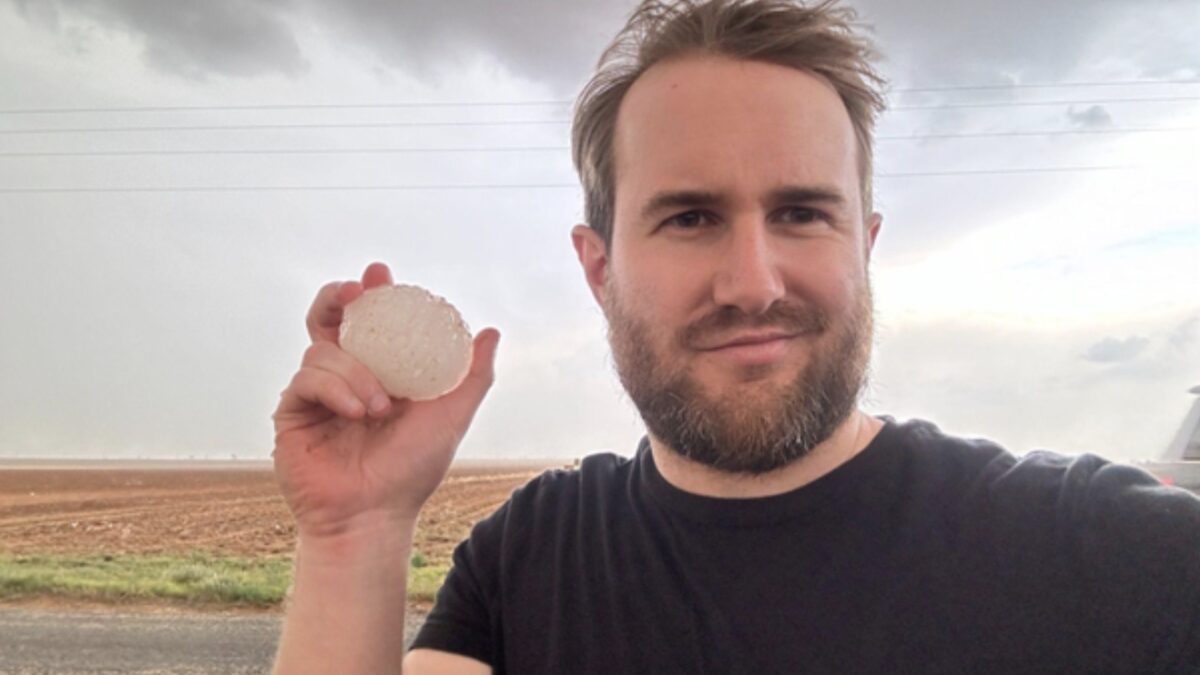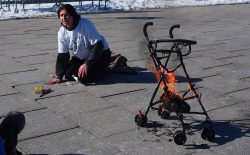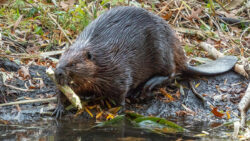Extreme storms have fascinated Ottawa’s Andrew Macklin his entire life. Whether it’s a brewing thunderstorm or a full-fledged tornado, Macklin always wants to get a front row seat to the action.
“My grandparents lived on a big hill overlooking Lake Ontario,” Macklin said. “I would sit in my grandfather’s lap and watch lightning every summer night. That really sparked my interest in weather.”
The childlike wonder has never faded for Macklin, as he has dedicated his free time to chasing violent storms across North America.
Macklin, 33, works as a biochemical analyst and lab manager for the Ottawa Hospital. He felt that ultimately meteorology wasn’t the career path for him, but he still has put in a lot of work to learn about extreme weather.
“As soon as I graduated from grad school for biochemistry, I wanted to treat myself,” Macklin said. “I went on a tour to ‘Tornado Alley’, and it completely enthralled me with the idea of chasing tornadoes.”
Tornado Alley is an area of the midwestern United States prone to intense storms. Macklin began the 2024 storm season in May by taking what he says is his last trip down there for a while, visiting Iowa, Colorado, Kansas, Oklahoma, Texas and New Mexico.
With the dramatic change in weather cycles in recent years, he doesn’t have to go so far south to witness tornadoes.
“Climate change, whether you believe in it or not, it is affecting our weather patterns,” Macklin said. “There is a theory out there that Tornado Alley is shifting east. I wouldn’t say it’s shifting; it’s just redistributing. Now storms can live longer with more hot temperatures. You’re starting to see a bit more of an uptick in those Tornado Alley-type storms more eastward in Ontario and Ohio.”
While the complexity of tornado formation and detection has made it difficult to fully determine how much climate change has caused an increase in the dangerous phenomenon, research has shown that the timing of extreme weather events could become much more unpredictable. Scientists have also shown that warmer temperatures are likely to lead to tornadoes occurring more frequently during fall and winter, making potentially destructive twisters a year-round concern.

Macklin says he wants to take a more local approach to storm chasing. While Ottawa doesn’t necessarily have the violent weather of the American Midwest, Macklin’s knowledge has allowed him to become one of the area’s most prominent amateur storm experts.
“After my trip, I was luckily working at York University, so I could shadow their meteorology courses at night,” Macklin said. “They also had a club for students and they would go down to Environment Canada every week. I was lucky that even though I wasn’t a student, the club let me tag along and I learned so much there.”
Macklin is the first person to use drone technology to film a tornado in Canada, accomplishing the feat in 2020 in Oxford Mills, about 70 kilometres south of Ottawa and Glencoe, about 50 kilometres southwest of London, Ont.
‘You could tell this was going to be beautiful and a beast. I was in a perfect position with the cameras and drones ready, and I decided to turn the car around to have a quicker getaway. I threw the car into reverse and the transmission didn’t work.’
— Andrew Macklin, storm chaser
The ability to track storms comes down to knowledge and skill.
“An analogy I use for finding storms is a boiling pot of water,” Macklin said. “It’s pretty tricky to tell where the first bubble of water will form, but there are bits of information you can use. What if the burner below the pot is zig-zagged or in a circular shape? Or maybe you didn’t clean the pot as good as you should’ve and you have food cake on the bottom. That could act as an activation point for the first bubble.”
Even with information about the conditions of the storm, being in the right spot to witness a twister is difficult.
“Realistically it’s about a 10-per-cent chance that the tornado will appear,” Macklin said. “But when it does pay off, it’s an amazing sight to see.”
While storm chasers dream of seeing extreme, high-power tornadoes, they also understand the risk and damage that extreme weather can cause.
“Every chaser will say the same thing,” Macklin said. “We want to see storms, but we want them to be in far out fields not damaging anything, person or property. In Ottawa, we’re more populated so we have to be conscious of that.”
Major tornadoes aren’t that common in Ottawa, but the city saw a record 13 tornado warnings in 2023. Barrhaven in suburban south Ottawa was hit by a devastating tornado in July 2023, which damaged 125 homes and displaced many residents.
The increase in tornado warnings was also just the tip of the iceberg, as Ottawa recorded over double the number of weather warnings in 2023 as it did 10 years earlier.
Macklin says he prioritizes being a cautious chaser, as he can’t afford for the hobby to negatively affect his life. Still, he says there have been some close calls encountered during his chasing.
“On my recent trip to Tornado Alley I had a bit of a freaky moment,” Macklin said. “I was in the perfect position right in front of this supercell, you could tell on radar we were about 10 minutes away from radar forming. You could tell this was going to be beautiful and a beast. I was in a perfect position with the cameras and drones ready, and I decided to turn the car around to have a quicker getaway. I threw the car into reverse and the transmission didn’t work.”
We want to see storms, but we want them to be in far out fields not damaging anything, person or property.
— Andrew Macklin
That storm was a part of a series of violent weather events that hit southwestern Oklahoma in May, some of which were reported to have caused major damage to several homes.
“I was freaking out because I was all alone at this point,” Macklin added. “Luckily after turning the car off and on a few times, it went into drive. At that point, I was freaked out and I got the heck out of there.”
Storm chasers’ findings often get reported to databases established by researchers who investigate the properties of various extreme weather events. Macklin contributes to Western University’s Northern Tornadoes Project, which investigates reported tornadoes to classify them using information submitted by trusted contributors.
In 2024, the London, Ont.-based NTP has so far investigated 80 different storms to see if they led to tornadoes touching down. The project has officially classified 60 events as tornadoes, while two others are undergoing the final classification process.
“Our understanding has changed enough that we keep having to update our protocols and our guidelines and everything to incorporate new knowledge that we gain,” said David Sills, executive director of the NTP. “Just as an example, we know tornadoes can get fairly wide, especially in the U.S. But we don’t have a lot of really wide tornadoes in Canada. But we documented a tornado that was in Northwestern Ontario that was all in the trees that was 2.4 kilometres wide.”
The NTP now has data going back to 1980, which has been gathered from a wide variety of sources, such as newspaper reports and old satellite imagery.
A goal of the NTP is to use its data to try to find correlations between extreme weather events and trends in climate change. Interestingly, the NTP researchers theorize that some effects of climate change have slowed down tornado formation during the peak season.
Our understanding has changed enough that we keep having to update our protocols and our guidelines and everything to incorporate new knowledge that we gain.
— David Sills, executive director, Northern Tornadoes Project, Western University
“We think there’s a connection with smoke,” Sills said. “It’s very smoky across the country because of the record area burned (from wildfires in Western Canada and elsewhere), and when the skies get (smoky), it doesn’t let a lot of sunlight through. So the energy for thunderstorms isn’t quite the same as what it would normally be.”
In addition to helping researchers understand storms better, the NTP aims to educate and get more people interested in extreme weather. Macklin says he has the same goal, as he is currently exploring avenues to share both his experience with extreme weather as well as tornado safety information in a time of climate disruption. Earlier in the year, he gave a presentation to a crowd at the Ottawa Public Library about storm chasing. He is now looking to build on this.
“I’m thinking of pooling resources with other chasers and doing a joint presentation,” Macklin said. “I’m starting to think that I want to do the high school circuit — that’s where I kind of want to take this.”
The goal is to teach the next generation about the reality of extreme weather and to perhaps inspire them to become interested in meteorology, just as Macklin did as a child sitting on his grandfather’s lap.
“There is a quote that I always go back to,” Macklin said. “And that’s ‘there are two people you should always try to make proud. Your eight year old self and your 80 year old self. And as you can see, I’ve made the storm-loving eight year old me very proud.”




